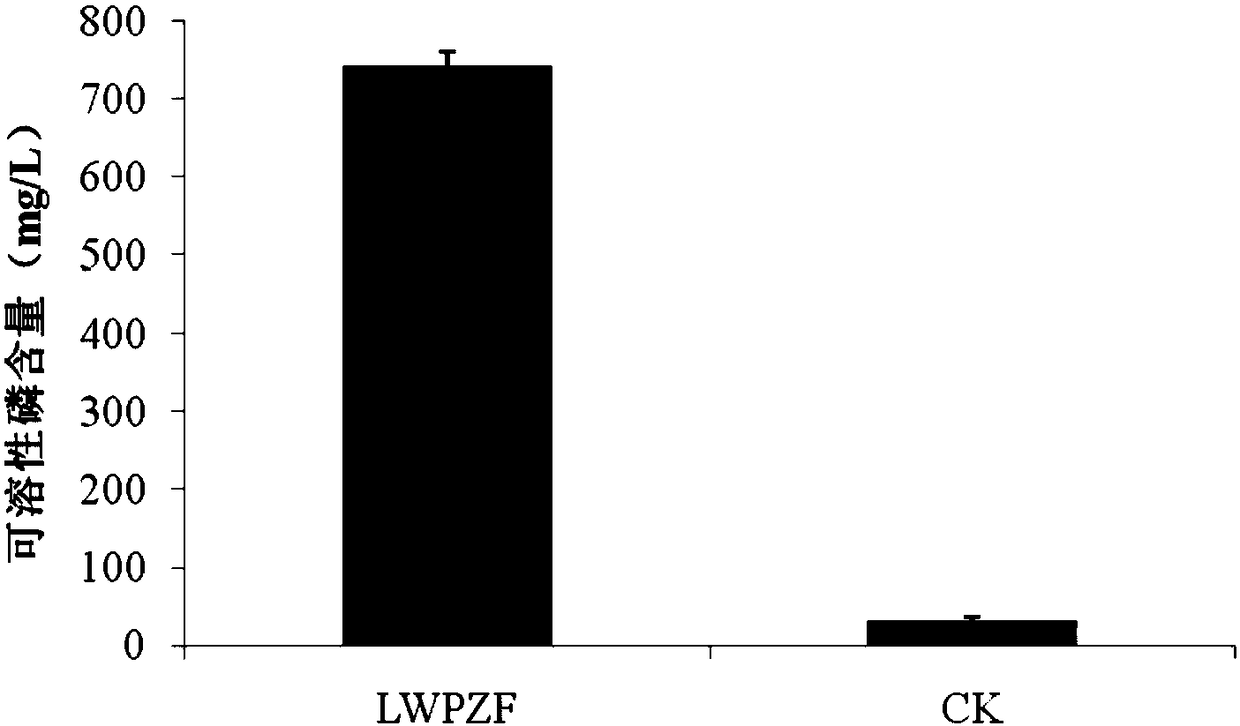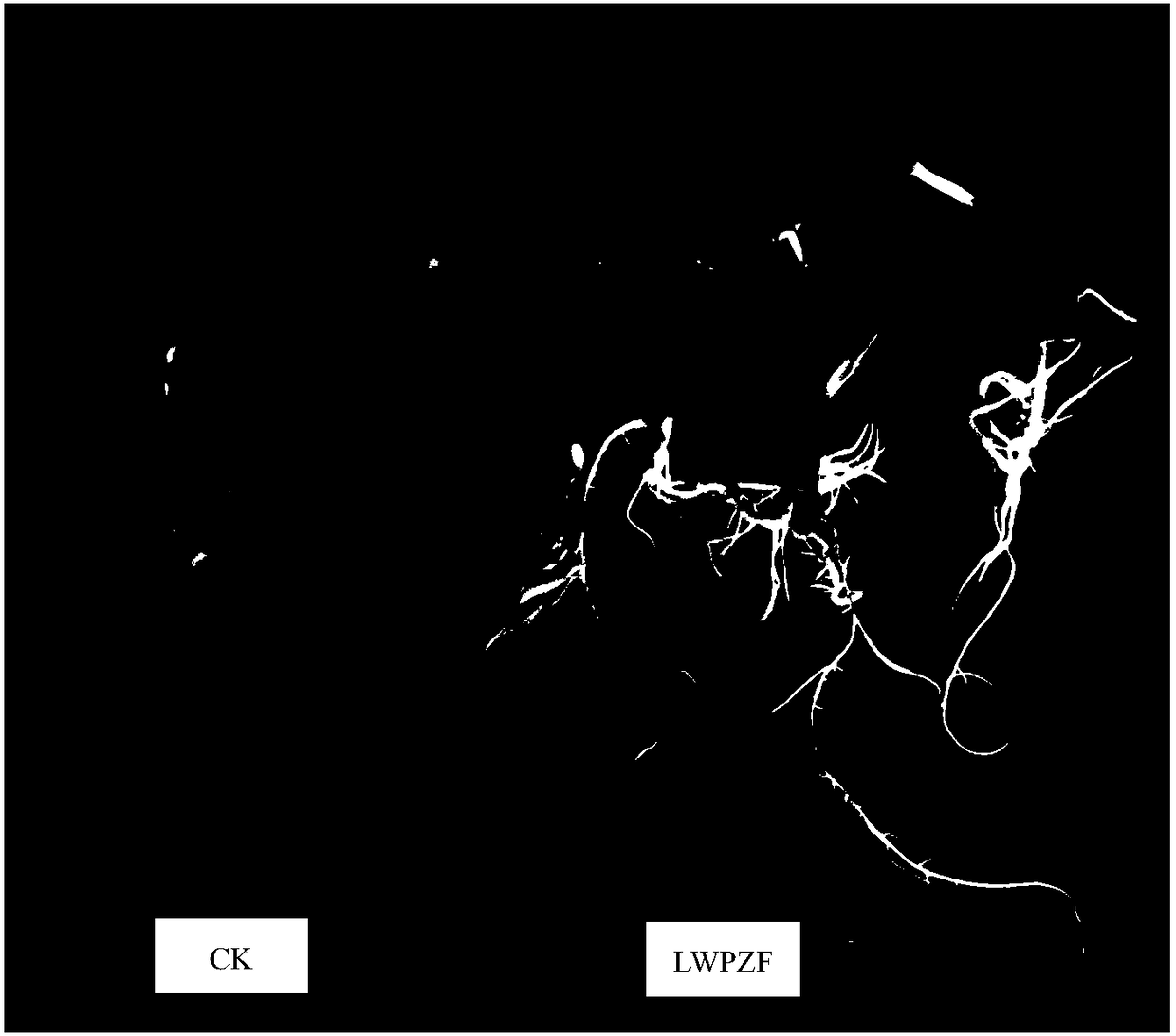A Pseudomonas putida and Its Application in Promoting the Growth of A.
A technology of Pseudomonas putida and Cinnamomum, which is applied in the field of biological fertilizers and microbial fertilizers, can solve the problems of no growth-promoting bacteria of Cinnamon, achieve excellent strain resources, promote growth and development, and promote seed germination and growth. Effect
- Summary
- Abstract
- Description
- Claims
- Application Information
AI Technical Summary
Problems solved by technology
Method used
Image
Examples
Embodiment 1
[0026] Example 1: Determination of the phosphorus-dissolving ability of LWPZF liquid.
[0027] NBRIP medium: glucose 10g, Ca 3 (PO 4 ) 2 5.0g, MgCl 2 5g, MgSO 4 ·7H 2 O 0.25g, KCl0.2g, (NH 4 ) 2 SO 4 0.1g, distilled water 1000mL, pH 7.0.
[0028] The LWPZF strain activated twice was inoculated into NB medium (3.0 g of beef extract, 10.0 g of peptone, 5.0 g of sodium chloride, 1000 mL of distilled water, pH 7.2-7.4), and cultured at 30°C for 18-24 hours to make a seed solution. 0.5mL seed solution was inoculated into a 100mL Erlenmeyer flask containing 50mL NBRIP culture solution, and the NBRIP medium inoculated with 0.5mL blank seed solution was used as a control. Each treatment was replicated three times, 30°C, 180r / min shaking culture for 4 days. The fermented liquid was centrifuged at 10000r / min for 10min at 4°C, and the molybdenum-antimony anti-colorimetric method was used to measure the soluble phosphorus content in the fermented liquid ( figure 1 ).
[0029...
Embodiment 2
[0029] from figure 1 It can be seen from the figure that the soluble phosphorus content in the fermentation liquid inoculated with LWPZF strain was 742.04 mg·L -1 , is the control (32.81mg·L -1 ) 22.6 times. In summary, the LWPZF strain has a strong ability to degrade calcium phosphate. Example 2: Determination of the ability of LWPZF to produce auxin.
[0030] King's B medium: peptone 20g, MgSO 4 ·7H 2 O 1.5g, K 2 HPO 4 1.5g, glycerol 10mL, agar 15g, after adjusting the pH value to 7.0, add to 1000mL.
[0031] S1 colorimetric solution: accurately weigh 12g FeCl 3 Dissolve in 300mL of deionized water, then slowly add 429.7mL of concentrated sulfuric acid, and dilute to 1L after cooling.
[0032] Prepare IAA standard solutions with concentrations of 1, 4, 6, 8, 10, 12, 14, 16, 18, and 20 mg / L, and mix them with S1 reagent at a volume ratio of 1:1, place them at room temperature in the dark for 30 minutes, and then Determine the OD of each concentration 530nm (The 1:...
Embodiment 3
[0035] Example 3: Determination of the ability of LWPZF to promote growth of cucumber seeds.
[0036] The cucumber seeds were treated with 10% hydrogen peroxide for 20 minutes, washed 5-6 times with sterile water, and dried for later use.
[0037] The LWPZF strain was inoculated in NB liquid medium, and cultured on a shaker at 28°C for 24-36 hours, so that the bacterial concentration reached 10 9 cfu / mL. The bacterial suspension was serially diluted to 10 -7 , divide the bottom of the sterile petri dish into 8 equal parts with a marker pen, mark CK, -1, -2, -3, -4, -5, -6, -7 in turn, place 4~ 6 pieces of filter paper, put sterile absorbent cotton in the middle, put the processed cucumber seeds on the filter paper, drop 100 μl of LWPZF bacterial suspension corresponding to the dilution in the center of the filter paper in each area of the bottom of the dish, drop in the CK area, etc. Amount of sterile water was used as a control. 28°C, cultivated under light, and observe...
PUM
 Login to View More
Login to View More Abstract
Description
Claims
Application Information
 Login to View More
Login to View More - R&D
- Intellectual Property
- Life Sciences
- Materials
- Tech Scout
- Unparalleled Data Quality
- Higher Quality Content
- 60% Fewer Hallucinations
Browse by: Latest US Patents, China's latest patents, Technical Efficacy Thesaurus, Application Domain, Technology Topic, Popular Technical Reports.
© 2025 PatSnap. All rights reserved.Legal|Privacy policy|Modern Slavery Act Transparency Statement|Sitemap|About US| Contact US: help@patsnap.com



